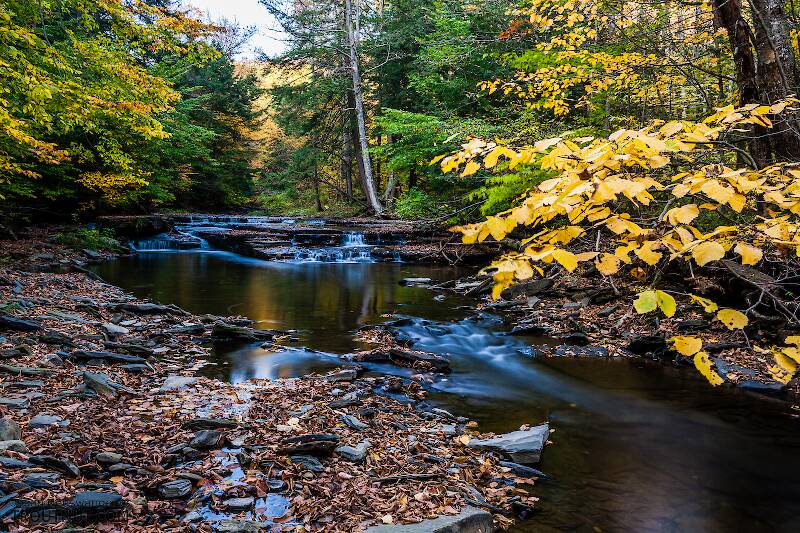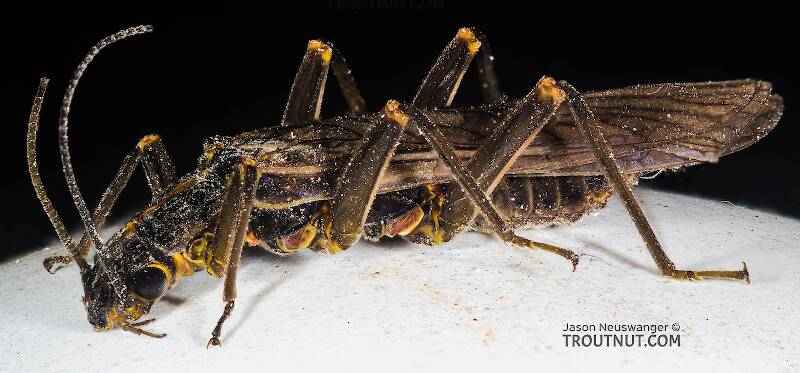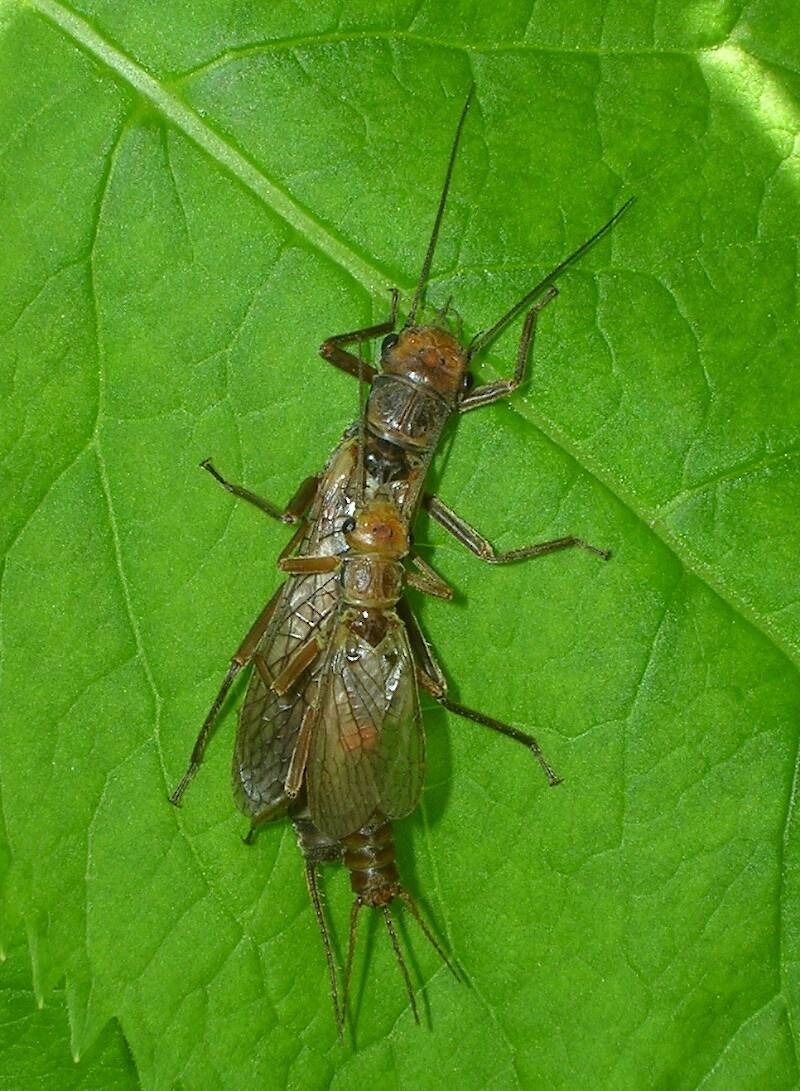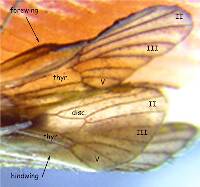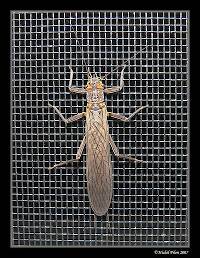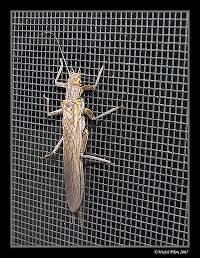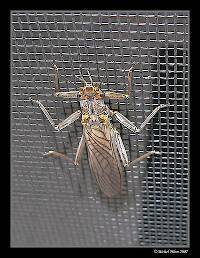
Blue-winged Olives
Baetis
Tiny Baetis mayflies are perhaps the most commonly encountered and imitated by anglers on all American trout streams due to their great abundance, widespread distribution, and trout-friendly emergence habits.
Featured on the forum

Troutnut is a project started in 2003 by salmonid ecologist Jason "Troutnut" Neuswanger to help anglers and
fly tyers unabashedly embrace the entomological side of the sport. Learn more about Troutnut or
support the project for an enhanced experience here.
GONZO on Jul 26, 2011July 26th, 2011, 6:04 am EDT
Hi Tim,
Overall, these have the appearance of perlids, probably a short-winged member of the Acroneuriini tribe. The best guess I can offer is that they might be something like Doroneuria theodora, a species that can have normal-winged to short-winged adults of both sexes. As far as I can tell, that species is not reported from ND, though the stonefly collection record for your state seems extremely sparse. Other predominantly Western perlids (like Hesperoperla pacifica and Claassenia sabulosa) have been reported from SD.
Overall, these have the appearance of perlids, probably a short-winged member of the Acroneuriini tribe. The best guess I can offer is that they might be something like Doroneuria theodora, a species that can have normal-winged to short-winged adults of both sexes. As far as I can tell, that species is not reported from ND, though the stonefly collection record for your state seems extremely sparse. Other predominantly Western perlids (like Hesperoperla pacifica and Claassenia sabulosa) have been reported from SD.
Entoman on Jul 27, 2011July 27th, 2011, 2:11 pm EDT
Tim and Lloyd -
This looks like it could be Claassenia sabulosa (Golden Stonefly or Willowfly) to me with a couple of caveats. My reasoning is that the males are usually brachypterous and this specimen appears to also have the darkly sclerotized genital hooks (at their tips). The head/pronotum relationship looks like sabulosa as well. The clincher would be to see a ventral of the male whose hammer should be rounded and about as wide as long instead of rectangular with substantial differences between length and width as on other western perlids (excepting Perlesta which has no hammer). Also, Claassenia sabulosa has been reported from the Black Hills (for what that is worth).
Caveat #1 - Though less often, Doroneuria theodora males can also be brachypterous and I think I might be seeing the mesal band on the 10th tergum dividing it. If present, this is a significant trait separating it from the other genera.
Caveat #2 - There is some confusion caused over the ocelli count. In the photo, it looks to be possibly two. This is an important female trait in determining between the genera. Anacroneuria and Neoperla, supposedly of South American and eastern US distribution respectively, are the only closely related genera where the females have only two.
Sorry for only adding options, but I can't seem to enlarge the photo which is preventing me from taking a closer look. Lloyd, perhaps you can enlarge the photo to check out the last abdominal segments and make out the ocelli count?
Regards,
Kurt
This looks like it could be Claassenia sabulosa (Golden Stonefly or Willowfly) to me with a couple of caveats. My reasoning is that the males are usually brachypterous and this specimen appears to also have the darkly sclerotized genital hooks (at their tips). The head/pronotum relationship looks like sabulosa as well. The clincher would be to see a ventral of the male whose hammer should be rounded and about as wide as long instead of rectangular with substantial differences between length and width as on other western perlids (excepting Perlesta which has no hammer). Also, Claassenia sabulosa has been reported from the Black Hills (for what that is worth).
Caveat #1 - Though less often, Doroneuria theodora males can also be brachypterous and I think I might be seeing the mesal band on the 10th tergum dividing it. If present, this is a significant trait separating it from the other genera.
Caveat #2 - There is some confusion caused over the ocelli count. In the photo, it looks to be possibly two. This is an important female trait in determining between the genera. Anacroneuria and Neoperla, supposedly of South American and eastern US distribution respectively, are the only closely related genera where the females have only two.
Sorry for only adding options, but I can't seem to enlarge the photo which is preventing me from taking a closer look. Lloyd, perhaps you can enlarge the photo to check out the last abdominal segments and make out the ocelli count?
Regards,
Kurt
"It's not that I find fishing so important, it's just that I find all other endeavors of Man equally unimportant... And not nearly as much fun!" Robert Traver, Anatomy of a Fisherman
GONZO on Jul 27, 2011July 27th, 2011, 6:34 pm EDT
C. sabulosa males are short-winged, Kurt, but the females are long-winged with the wings extending well past the end of the abdomen and often concealing the cerci as well. Both the male and the female in this photo are short-winged to varying degrees. Where do you think you see the "darkly sclerotized" tips of the genital hooks?
The median ocellus is hard to see in both of Tim's stoneflies, but these are clearly not Neoperla (or Perlinella, which is another eastern perlid genus that can have or appear to have only two ocelli). As far as I know, Anacroneuria is a Central American and South American genus.
The median ocellus is hard to see in both of Tim's stoneflies, but these are clearly not Neoperla (or Perlinella, which is another eastern perlid genus that can have or appear to have only two ocelli). As far as I know, Anacroneuria is a Central American and South American genus.
Entoman on Jul 27, 2011July 27th, 2011, 7:44 pm EDT
Hi Lloyd,
I'm glad you concur about Neoperla and Anacroneuria, I just can't make out the median ocellus. The Black Hills are such a unique region of western and midwestern influences, I didn't want to excude anything out of assumtion.
As far as the genital hooks, I can just make out two distinct tiny dark blurs off the terminalia and can't tell for sure what they are.
Long wings are my experience as well, but are you sure that brachypterous wings aren't possible in the females of sabulosa? The head and pronotum on sabulosa are a pretty tight fit whereas theodora has a noticable neck (at least the nymph) if I remember right.
Are you able to make out the tenth tergum for the mesal band? If there, it should go from the middle to the posterior margin. It may look like a crease or be stretched a little. No need to get too picky about this though as sabulosa this area will appear fairly smooth. Like I said, I think I might be able to see it but The biggest I can get this picture is 4 X 6, which isn't enough to make out this kind of detail. If it's there I think we have our answer.
Other clues would be date of emergence as sabulosa is pretty much a fall emerger in my experience. If Tim still has the specimens, he should be able to look for the hammer. The difference between the two is dramatic. In sabulosa, it's a slight oval held horizontally. In theodora it looks like a long vertical finger nail trimmed straight and has twice the volume and easily visible to the naked eye.
Kurt
I'm glad you concur about Neoperla and Anacroneuria, I just can't make out the median ocellus. The Black Hills are such a unique region of western and midwestern influences, I didn't want to excude anything out of assumtion.
As far as the genital hooks, I can just make out two distinct tiny dark blurs off the terminalia and can't tell for sure what they are.
Long wings are my experience as well, but are you sure that brachypterous wings aren't possible in the females of sabulosa? The head and pronotum on sabulosa are a pretty tight fit whereas theodora has a noticable neck (at least the nymph) if I remember right.
Are you able to make out the tenth tergum for the mesal band? If there, it should go from the middle to the posterior margin. It may look like a crease or be stretched a little. No need to get too picky about this though as sabulosa this area will appear fairly smooth. Like I said, I think I might be able to see it but The biggest I can get this picture is 4 X 6, which isn't enough to make out this kind of detail. If it's there I think we have our answer.
Other clues would be date of emergence as sabulosa is pretty much a fall emerger in my experience. If Tim still has the specimens, he should be able to look for the hammer. The difference between the two is dramatic. In sabulosa, it's a slight oval held horizontally. In theodora it looks like a long vertical finger nail trimmed straight and has twice the volume and easily visible to the naked eye.
Kurt
"It's not that I find fishing so important, it's just that I find all other endeavors of Man equally unimportant... And not nearly as much fun!" Robert Traver, Anatomy of a Fisherman
Entoman on Jul 27, 2011July 27th, 2011, 8:21 pm EDT
Tim,
Any idea as to the size of the specimens and date of capture? That's either a big leaf, or these are much smaller bugs than we think, in which case all bets are off.:)
BTW - Wecome!! I was away fishing when you signed up.
Kurt
Any idea as to the size of the specimens and date of capture? That's either a big leaf, or these are much smaller bugs than we think, in which case all bets are off.:)
BTW - Wecome!! I was away fishing when you signed up.
Kurt
"It's not that I find fishing so important, it's just that I find all other endeavors of Man equally unimportant... And not nearly as much fun!" Robert Traver, Anatomy of a Fisherman
GONZO on Jul 27, 2011July 27th, 2011, 8:33 pm EDT
As far as the genital hooks, I can just make out two distinct tiny dark blurs off the terminalia and can't tell for sure what they are.
Do you mean the two dark spots between the cerci at the very tip of the abdomen?
Long wings are my experience as well, but are you sure that brachypterous wings aren't possible in the females of sabulosa?
I suppose anything is possible, Kurt. Let's just say that I have never seen any examples where the sabulosa females had short wings, nor have I ever read anything about it in the scientific lit. Speaking of ocelli, the rear (lateral) ocelli of male C. sabulosa are usually much closer together (often separated by only the diameter of a lateral ocellus) and noticeably larger than the those of the female. That is not the case in Tim's specimens.
Have you tried pressing "Ctrl" and "+" simultaneously on your keyboard to enlarge the photo?
Entoman on Jul 27, 2011July 27th, 2011, 9:44 pm EDT
Ah! Thanks Lloyd for getting me to tinker. The shortcut didn't work, but I tried dragging the image a second time from the photobucket image that came up with my first drag. Presto! unlocked and available.
Fortunately the image has enough resolution to see definitely:
a. the terminalia is clearly that of theodora. The dark spots I thought I saw are just shade areas of the tail roots.
b. The tails are basaly angled more laterally as with theodora and the much smaller processes are mounted between the cerci as they should be.
c. The mesal band is clearly visible on the 10th segment
d. The larger separation between head and pronotum I was looking for showed up on the male in the enlargement.
No, just thought those were gill remnants. Enlargement shows otherwise as mentioned above.
Me either, but as you said, "you never know," especially dealing with a unique ecosystem. Anyway, the point is mute now.
Interesting observation. I never noticed that before. I will look for this feature.
OK, Tim I think we have a resolution. Doroneuria theodora it is (probably). Another bug that's where it hasn't been reported before Lloyd? :)
Fortunately the image has enough resolution to see definitely:
a. the terminalia is clearly that of theodora. The dark spots I thought I saw are just shade areas of the tail roots.
b. The tails are basaly angled more laterally as with theodora and the much smaller processes are mounted between the cerci as they should be.
c. The mesal band is clearly visible on the 10th segment
d. The larger separation between head and pronotum I was looking for showed up on the male in the enlargement.
Do you mean the two dark spots between the cerci at the very tip of the abdomen?
No, just thought those were gill remnants. Enlargement shows otherwise as mentioned above.
I suppose anything is possible, Kurt. Let's just say that I have never seen any examples where the sabulosa females had short wings, nor have I ever read anything about it in the scientific lit.
Me either, but as you said, "you never know," especially dealing with a unique ecosystem. Anyway, the point is mute now.
...the rear (lateral) ocelli of male C. sabulosa are usually much closer together...
Interesting observation. I never noticed that before. I will look for this feature.
OK, Tim I think we have a resolution. Doroneuria theodora it is (probably). Another bug that's where it hasn't been reported before Lloyd? :)
"It's not that I find fishing so important, it's just that I find all other endeavors of Man equally unimportant... And not nearly as much fun!" Robert Traver, Anatomy of a Fisherman
Bioprofsd on Aug 1, 2011August 1st, 2011, 2:00 pm EDT
Unfortunately, I did not collect the specimens. I wish now that I had collected them. I took the picture around July 14, 2011.
Thanks for all of your astute observations. Next time I'll have some vials ready to collect specimens.
BTW, that was a very big leaf. It was probably cow parsnip.
Thanks for all of your astute observations. Next time I'll have some vials ready to collect specimens.
BTW, that was a very big leaf. It was probably cow parsnip.
Entoman on Aug 3, 2011August 3rd, 2011, 5:58 pm EDT
Hi Tim,
You're welcome. Thanks for clarification on the leaf.:)
BTW - Bob Newell just posted some excellent photos of C. sabulosa on the hatch page. His post is also listed on the forum as an update for today. Of particular interest is the male. One of the ventral shots clearly shows the ovalish round hammer I mentioned. I have found that knowing them is an excellent way to quickly recognize what you're looking at streamside (at least for the western male perlids). The ocelli spacing looks as I remember, so I'm confused (nothing new) by Lloyd's comment regarding that issue. Anyway, the photos are worth a parousal.
Regards,
Kurt
You're welcome. Thanks for clarification on the leaf.:)
BTW - Bob Newell just posted some excellent photos of C. sabulosa on the hatch page. His post is also listed on the forum as an update for today. Of particular interest is the male. One of the ventral shots clearly shows the ovalish round hammer I mentioned. I have found that knowing them is an excellent way to quickly recognize what you're looking at streamside (at least for the western male perlids). The ocelli spacing looks as I remember, so I'm confused (nothing new) by Lloyd's comment regarding that issue. Anyway, the photos are worth a parousal.
Regards,
Kurt
"It's not that I find fishing so important, it's just that I find all other endeavors of Man equally unimportant... And not nearly as much fun!" Robert Traver, Anatomy of a Fisherman
Quick Reply
Related Discussions
Topic
Replies
Last Reply
1
Sep 9, 2008
by GONZO
by GONZO
4
Mar 11, 2012
by Entoman
by Entoman
6
Nov 12, 2006
by Martinlf
by Martinlf

